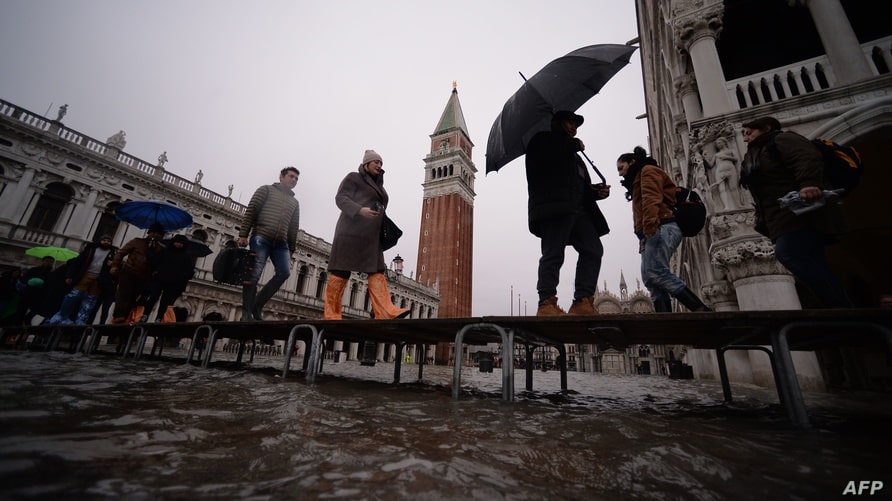
VENICE: Venice closed its iconic St Mark´s Square on Sunday ahead of the third major flooding in less than a week, as rain lashed the rest of Italy and warnings were issued in Florence and Pisa.
Venice forecast an “acqua alta”, or high water, of 160 centimetres (over five feet) for Sunday, lower than Tuesday´s 187 centimetres — the highest level in half a century — but still dangerous.
“Maximum attention for today´s tide,” tweeted mayor Luigi Brugnaro, who has estimated damage so far from the invading salt water at over one billion euros (dollars).
“Saint Mark´s square is closed. Safety first,” he said as the sea water began to swamp the already devastated historic city where authorities have declared a state of emergency.
To the south, Tuscany president Enrico Rossi tweeted a warning of a “flood wave” on the Arno and said boards were being installed on the swollen river´s banks in Pisa “as a precautionary measure”.
Italian media showed paratroopers helping to bolster river defences in Pisa, with authorities monitoring the same river in Florence after heavy rain made it rise dramatically overnight.
Arno flooding devastated Renaissance jewel Florence in 1966, killing around 100 people and destroying thousands of priceless works of art. Civil protection units in Florence advised citizens “not to stand near the Arno´s river banks”.
The renewed threat from exceptionally intense high tides in Venice came after a brief respite on Saturday.
Emergency workers removed temporary walkways from St Mark´s square as the water started to rise on Sunday, with only police and soldiers visible at around midday.
The top tourist site had already been shut for several hours on Friday as strong storms and winds battered the region, leaving it submerged by sea surges.
Churches, shops and homes have also been inundated in the city, a UNESCO World Heritage site.
A massive infrastructure project called MOSE has been under way since 2003 to protect the city, but the multi-billion euro project has been plagued by cost overruns, corruption scandals and delays.
“We weren´t expecting the high waters to be so exceptionally high,” said Guido Fulgenzi, who had planned to open his cafe on St Mark´s square this week.
“We´re paying the prices” for the MOSE project not being completed, he said, sloshing around in his flooded kitchen and pointing to Tuesday´s high water mark on the wall.
The crisis has prompted the government to release 20 million euros ($22 million) in funds to tackle the devastation.
Culture Minister Dario Franceschini has warned the task of repairing the city, where more than 50 churches have suffered damage, will be huge.
Residents whose houses have been hit are eligible for up to 5,000 euros in immediate government aid, while restaurant and shop owners can receive up to 20,000 euros and apply for more later.
Most of the city´s cash machines were no longer working because of the water, making life even more difficult for tourists and Venetians.
Older residents who remember the infamous “acqua alta” of 1966, when the water rose to a level of 1.94 metres, say they have not seen such frequent flooding before.
Hotels reported cancelled reservations, some as far ahead as December, following the widespread diffusion of images of Venice underwater.
Tuesday´s high waters submerged around 80 percent of the city, officials said.
Many, including Venice´s mayor, have blamed the disaster on global warming and warned that the country prone to natural disasters must wake up to the risks posed by ever more volatile seasons.
The Serenissima, as the floating city is called, is home to 50,000 residents but receives 36 million visitors each year.













